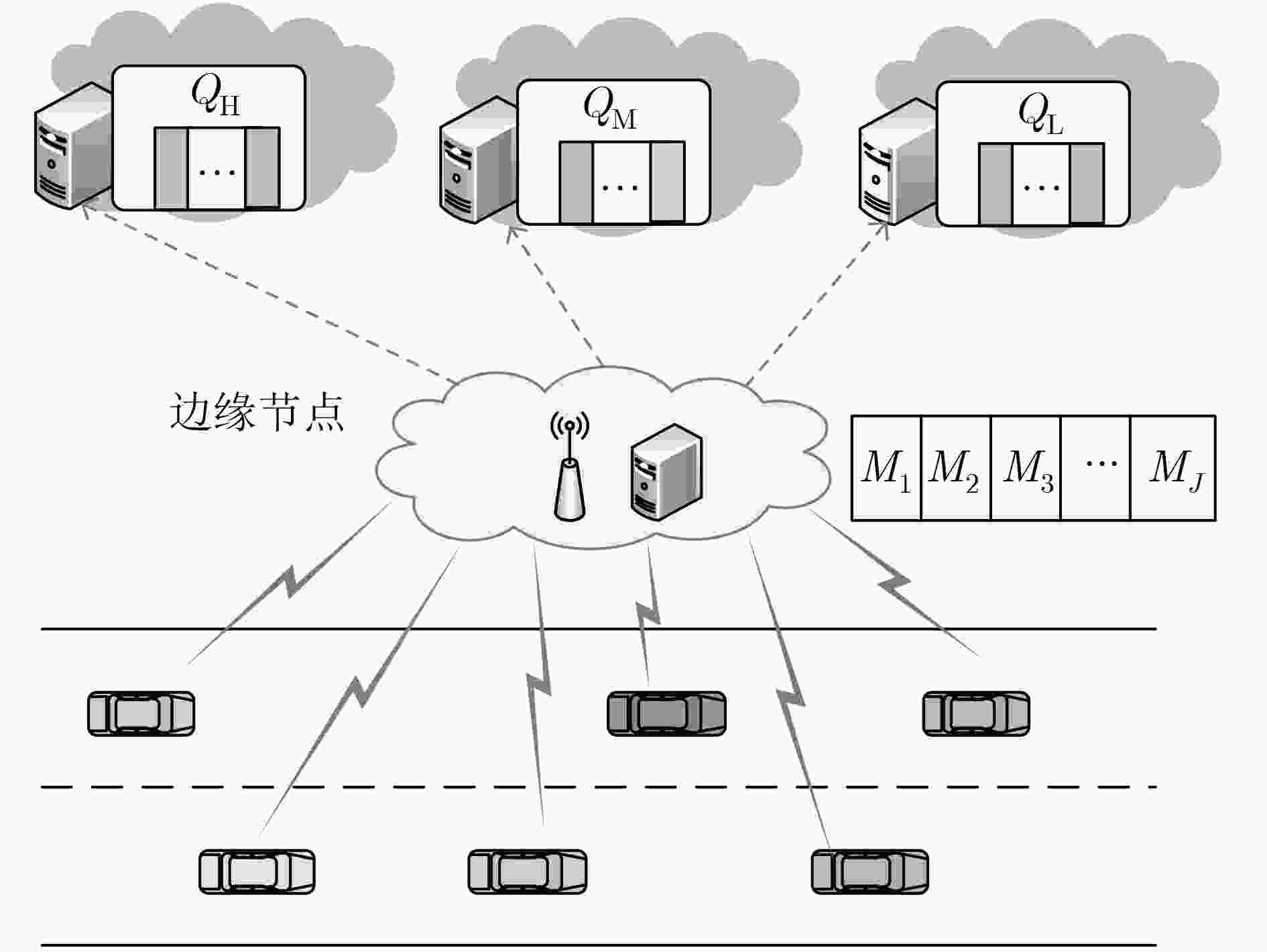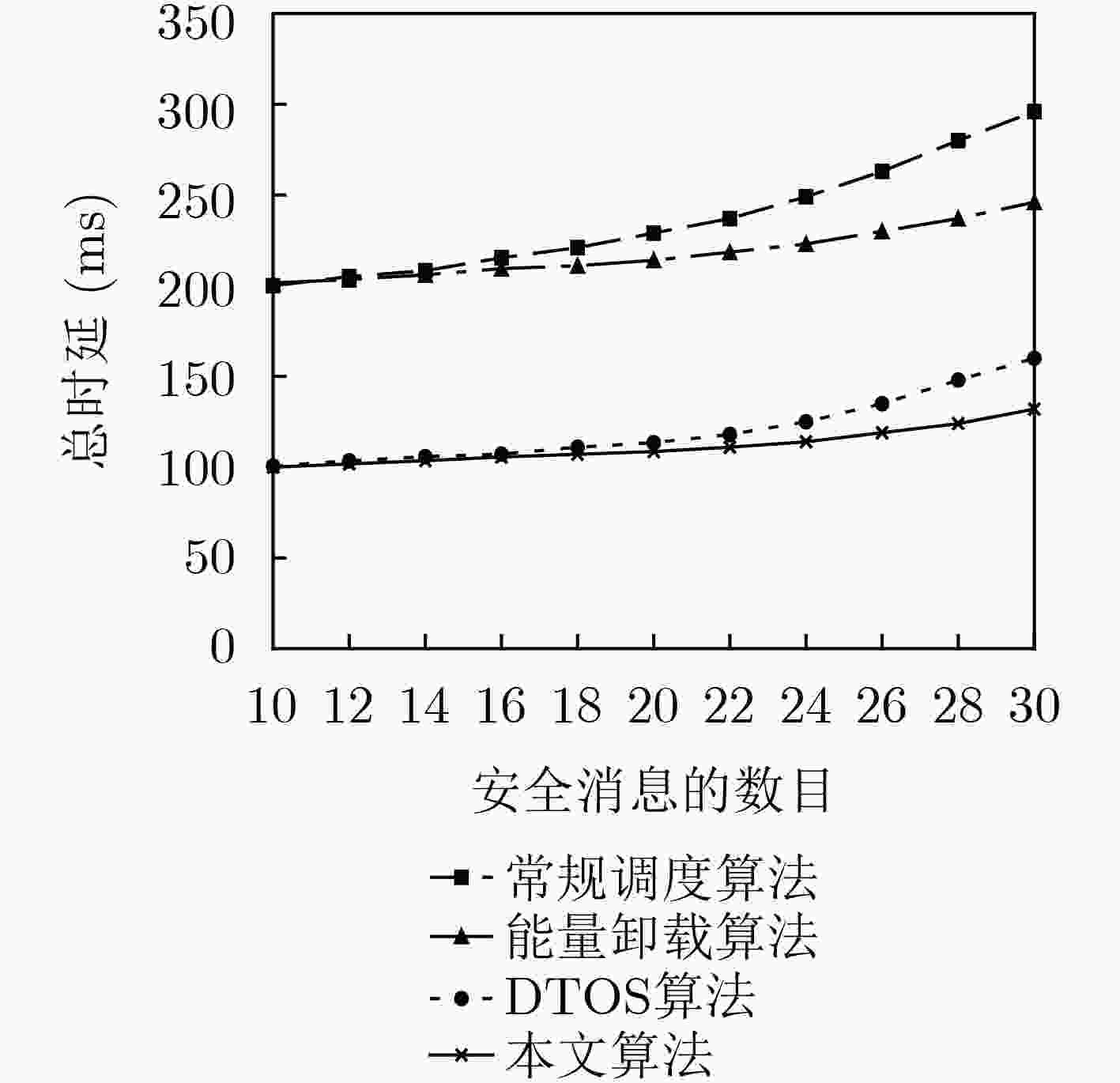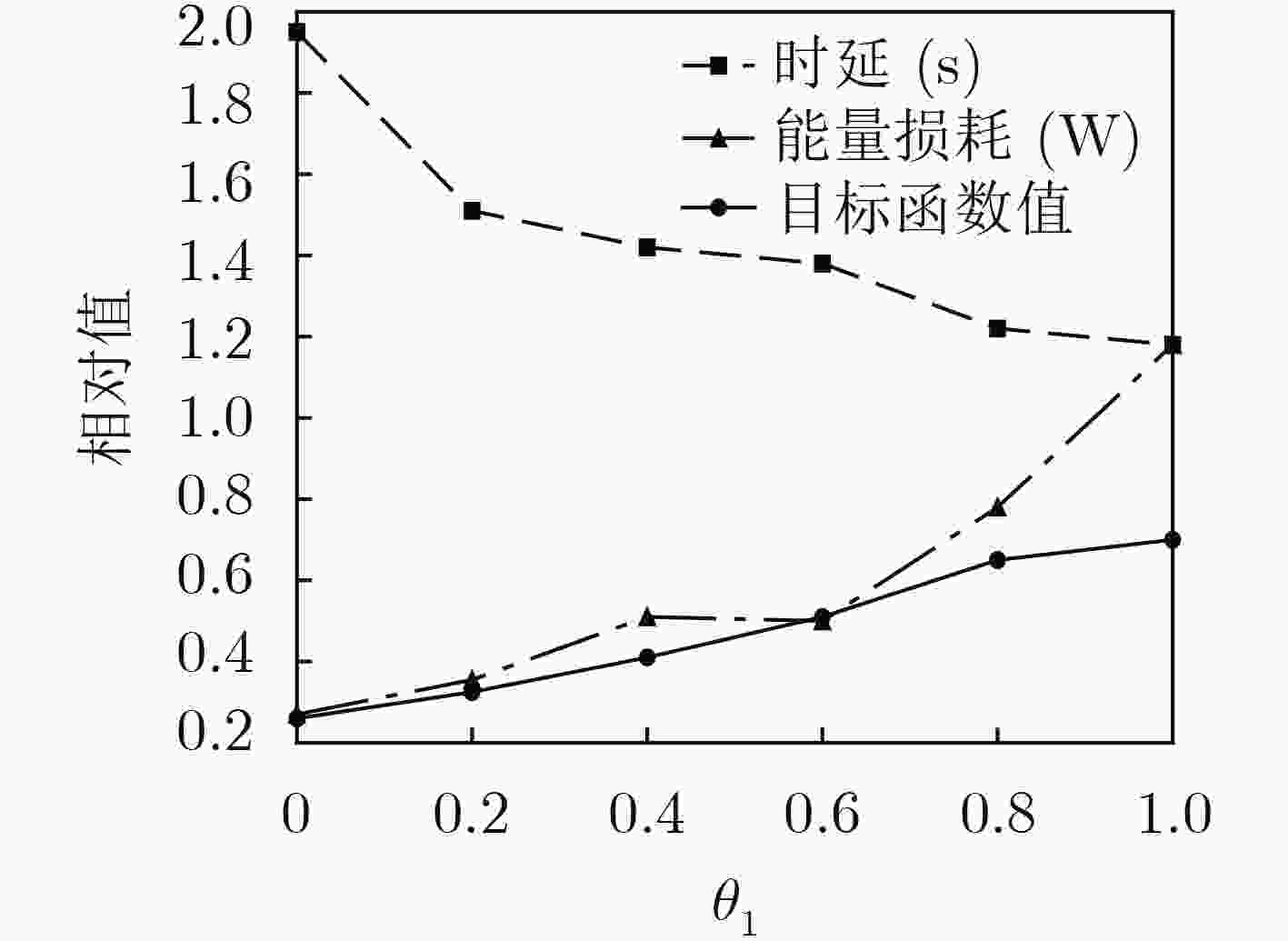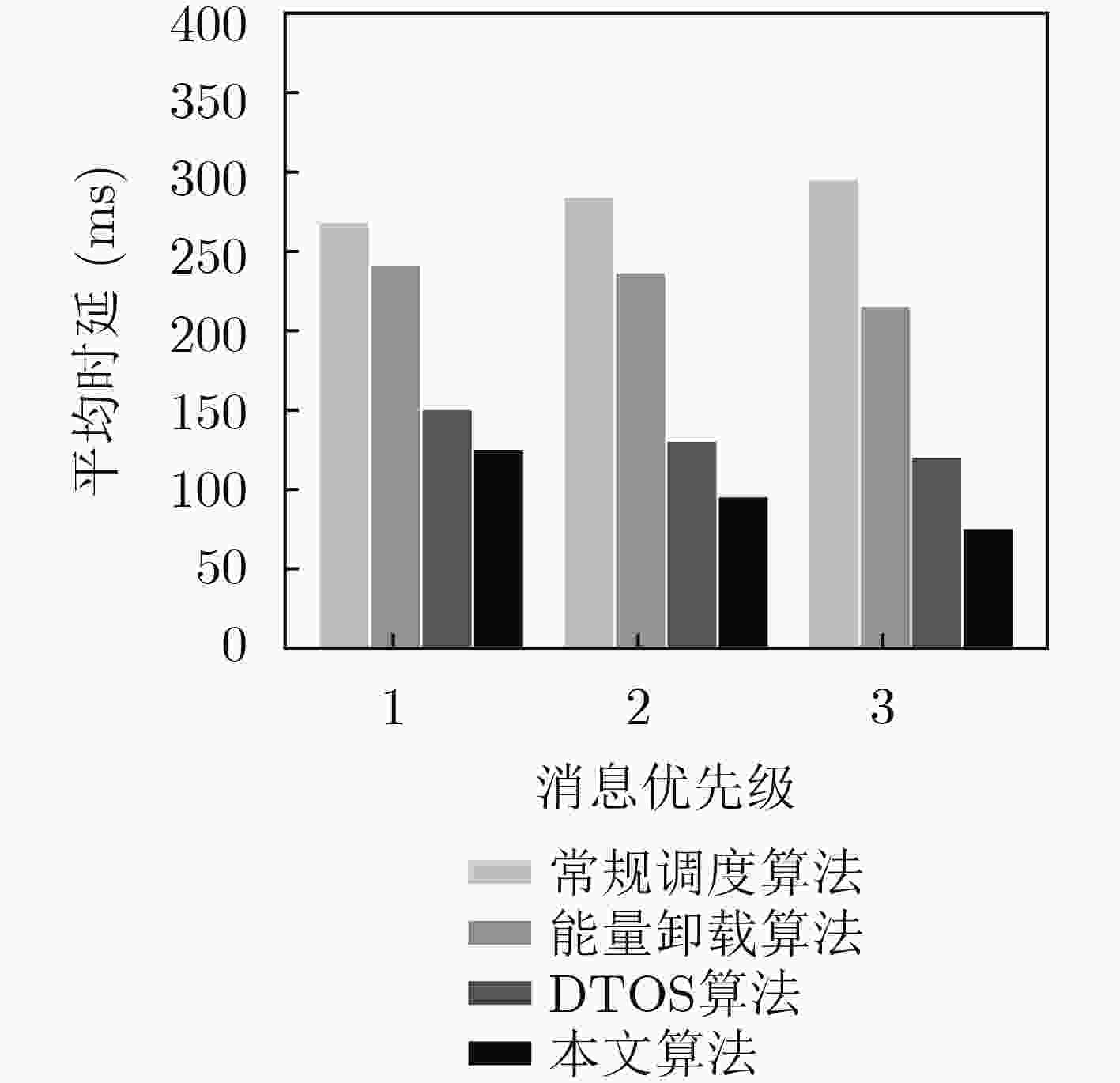Research on Content-aware Classification Offloading Algorithm Based on Mobile Edge Calculation in the Internet of Vehicles
-
摘要: 随着智能交通的快速发展,车辆终端产生大量需要实时处理的数据消息,而在有限资源上的竞争将会增加消息处理的时延,且对终端设备造成很大的能量消耗。针对时延和能量损耗的均衡关系,该文提出一种基于移动边缘计算(MEC)的内容感知分类卸载算法。首先根据层次分析法对安全消息进行优先级划分,然后建立时延和能量损耗的最优任务卸载模型,通过给时延和能量损耗赋予不同的权重系数构造关系模型,并利用拉格朗日松弛法将非凸问题转化为凸问题,从而结合次梯度投影法和贪婪算法得到问题的可行解。性能评估结果表明,该算法在一定程度上改善了消息处理时延和能量损耗。Abstract: With the rapid development of intelligent transportation, vehicle terminals generate a large number of data messages that need to be processed in real time. Competition on limited resources will increase the delay of message processing and energy consumption for terminal equipment. For the equilibrium relationship between delay and energy loss, this paper proposes a content-aware classification offloading algorithm based on Mobile Edge Computing (MEC). Firstly, the security message is prioritized according to the analytic hierarchy process, and then the optimal task unloading model of delay and energy loss is established. The relational model is established by assigning different weight coefficients to delay and energy loss. The Lagrangian relaxation method is used to transform the non-convex problem into a convex problem, which combines the sub-gradient projection method and the greedy algorithm to obtain the feasible solution. The performance evaluation results show that the algorithm improves the message processing delay and energy loss to some extent.
-
Key words:
- Mobile Edge Computing (MEC) /
- Computational offloading /
- Message priority /
- Delay
-
表 1 任务队列调度算法
(1) 输入消息的数据大小、消息所需的CPU周期、截止期限要求
和消息的优先级别${b_j}$, Cj, Tj 和Pj;
(2) for 边缘服务器中的每个安全消息Mj;(3) if pj=3,则 (4) 将消息Mj放置在QH队列中; (5) 构建层次分析矩阵A$ = {({a_{ij}})_{n \times n}}$; (6) 计算影响因素所对应的权重矢量$U_r^k$; (7) 根据层次分析矩阵获得其权重所对应的特征值
${{\varLambda}} {\rm{ = [}}{\lambda _1}, {\lambda _2},{\lambda _3}{{\rm{]}}^{\rm{T}}}$;(8) 通过${\mathbf{PV} }{\rm{ = } }\varDelta \times \varLambda $得到每个消息的优先级向量,即消息的
优先级值;(9) 根据PV值的大小在QH队列中按顺序排列; (10) else if pj=2,则 (11) 将消息Mi放置在QM队列中; (12) 重复步骤(4)—步骤(7); (13) 根据PV值的大小在QM队列中按顺序排列; (14) else if pj=1,则 (15) 将消息Mj放置在QL队列中; (16) 重复步骤(4)—步骤(7); (17) 根据PV值的大小在QL队列中按顺序排列; (18) End if; (19) End for; (20) End 表 2 消息任务卸载策略
(1) 输入:任务集$M$,边缘计算服务器集
$I$,分配的通信带宽为wij,分配的计算速率由vij;(2) 输出:分配系数$x$和目标函数值${z^ * }$; (3) for $i \in I$和$j \in M$; (4) 初始化拉格朗日乘数${\lambda ^0},{\lambda ^1},{\lambda ^2},{\lambda ^3}$,并根据式(11)求得传
输功率${p_{i,j}}$;(5) 计算${W_{i,j}}$和${V_{i,j}}$,设${z^ * }$=0; (6) if ${W_{i,j}} < {W_i}$和${V_{i,j}} < {V_i}$: (7) $x$=1; (8) else (9) $x$=0; (10) End if; (11) 利用$x$更新目标函数式(15); (12) 根据$g(\lambda )$的次梯度投影更新拉格朗日乘数,并利用
KKT条件更新传输功率${p_{i,j}}$;(13) End for; (14) End。 -
LIN Kai, LI Chensi, FORTINO G, et al. Vehicle route selection based on game evolution in social internet of vehicles[J]. IEEE Internet of Things Journal, 2018, 5(4): 2423–2430. doi: 10.1109/JIOT.2018.2844215 MINH Q T, KAMIOKA E, and YAMADA S. CFC-ITS: Context-aware fog computing for intelligent transportation systems[J]. IT Professional, 2018, 20(6): 35–45. doi: 10.1109/MITP.2018.2876978 TANG Shanjiang, LEE B S, and HE Bingsheng. Fair resource allocation for data-intensive computing in the cloud[J]. IEEE Transactions on Services Computing, 2018, 11(1): 20–33. doi: 10.1109/TSC.2016.2531698 LUO Guiyang, YUAN Quan, ZHOU Haibo, et al. Cooperative vehicular content distribution in edge computing assisted 5G-VANET[J]. China Communications, 2018, 15(7): 1–17. doi: 10.1109/CC.2018.8424578 赵星, 彭建华. 基于Lyapunov优化的隐私感知计算卸载方法[J]. 电子与信息学报, 2020. doi: 10.11999/JEIT190170ZHAO Xing and PENG Jianhua. A privacy-aware computation offloading method based on Lyapunov optimization[J]. Journal of Electronics &Information Technology, 2020. doi: 10.11999/JEIT190170 TRINH H, CALYAM P, CHEMODANOV D, et al. Energy-aware mobile edge computing and routing for low-latency visual data processing[J]. IEEE Transactions on Multimedia, 2018, 20(10): 2562–2577. doi: 10.1109/TMM.2018.2865661 张海波, 栾秋季, 朱江, 等. 车辆异构网中基于移动边缘计算的任务卸载与资源分配[J]. 物联网学报, 2018, 2(3): 36–43. doi: 10.11959/j.issn.2096-3750.2018.00062ZHANG Haibo, LUAN Qiuji, ZHU Jiang, et al. Task offloading and resource allocation in vehicle heterogeneous networks with MEC[J]. Chinese Journal on Internet of Things, 2018, 2(3): 36–43. doi: 10.11959/j.issn.2096-3750.2018.00062 TAO Xiaoyi, OTA K, DONG Mianxiong, et al. Performance guaranteed computation offloading for mobile-edge cloud computing[J]. IEEE Wireless Communications Letters, 2017, 6(6): 774–777. doi: 10.1109/LWC.2017.2740927 张海波, 李虎, 陈善学, 等. 超密集网络中基于移动边缘计算的任务卸载和资源优化[J]. 电子与信息学报, 2019, 41(5): 1194–1201. doi: 10.11999/JEIT180592ZHANG Haibo, LI Hu, CHEN Shanxue, et al. Computing offloading and resource optimization in ultra-dense networks with mobile edge computation[J]. Journal of Electronics &Information Technology, 2019, 41(5): 1194–1201. doi: 10.11999/JEIT180592 ALAMEDDINE H A, SHARAFEDDINE S, SEBBAH S, et al. Dynamic task offloading and scheduling for low-latency IoT services in multi-access edge computing[J]. IEEE Journal on Selected Areas in Communications, 2019, 37(3): 668–682. doi: 10.1109/JSAC.2019.2894306 GUO Shuaishuai, WU Dalei, ZHANG Haixia, et al. Resource modeling and scheduling for mobile edge computing: A service provider’s perspective[J]. IEEE Access, 2018, 6: 35611–35623. doi: 10.1109/ACCESS.2018.2851392 YOU Changsheng, HUANG Kaibin, CHAE H, et al. Energy-efficient resource allocation for mobile-edge computation offloading[J]. IEEE Transactions on Wireless Communications, 2017, 16(3): 1397–1411. doi: 10.1109/TWC.2016.2633522 SAMANTA A and CHANG Zheng. Adaptive service offloading for revenue maximization in mobile edge computing with delay-constraint[J]. IEEE Internet of Things Journal, 2019, 6(2): 3864–3872. doi: 10.1109/JIOT.2019.2892398 ALNOMAN A and ANPALAGAN A. A dynamic priority service provision scheme for delay-sensitive applications in fog computing[C]. The 29th Biennial Symposium on Communications, Toronto, Canada, 2018: 1–5. doi: 10.1109/BSC.2018.8494691. KIM G, JEON Y, and KIM J. A secure message service using the secure domain of a mobile security solution[C]. The 2014 International Conference on Information and Communication Technology Convergence, Busan, South Korea, 2014: 619–620. doi: 10.1109/ICTC.2014.6983230. LI Junjie. Analyzing key factors in Taiwanese teachers teaching in China with analytic hierarchy process[J]. Journal of Interdisciplinary Mathematics, 2018, 21(2): 307–316. doi: 10.1080/09720502.2017.1420561 YUAN Jie and LI Xiaoyong. A reliable and lightweight trust computing mechanism for iot edge devices based on multi-source feedback information fusion[J]. IEEE Access, 2018, 6: 23626–23638. doi: 10.1109/ACCESS.2018.2831898 LING Ping, KONG Xiangrui, FANG Chen, et al. Novel distributed state estimation method for the AC-DC hybrid microgrid based on the Lagrangian relaxation method[J]. The Journal of Engineering, 2019, 2019(18): 4932–4936. doi: 10.1049/joe.2018.9329 RANI E and KAUR H. Study on fundamental usage of CloudSim simulator and algorithms of resource allocation in cloud computing[C]. The 8th International Conference on Computing, Communication and Networking Technologies, Delhi, India, 2017: 1–7. doi: 10.1109/ICCCNT.2017.8203998. -






 下载:
下载:






 下载:
下载:
